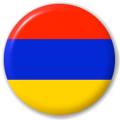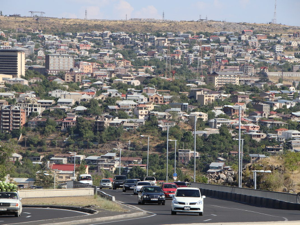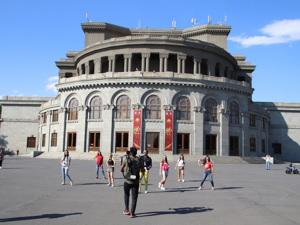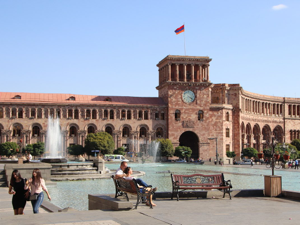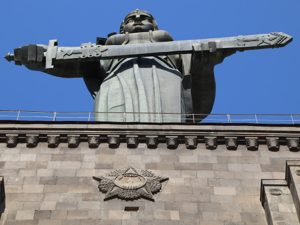Kyrgyzstan and Tajikistan 2018
Kyrgyzstan and Tajikistan 2018

Caucasus 2018
My final full day in Armenia was spent seeing two of Armenia’s architectural, historical and religious gems, as well as seeing some more of the modern urban development in Yerevan.
Setting off at 9:00am, we headed east from Yerevan, first stopping at a viewpoint to look south into Turkey to see Mount Ararat. We saw it, but it was no less hazy that our closer view a few days ago. It’s hard to know what to say about it – an extinct volcano where Noah’s Ark came to rest, it’s snow-capped, it’s big, and it’s very hazy. There was also a view of Yerevan from the same viewpoint; it wasn’t a great view, but it was better than the view of Mount Ararat. In answer to the question “can Mount Ararat ever be seen clearly?”, the answer was “it is sometimes clear in winter”. If I had been less diplomatic, I could have added “it’s probably clear when seen from within Turkey”, but I kept my thoughts to myself.
We continued east to Garni, one of Armenia’s significant villages that is famous for having the only reconstructed pagan fortress. Situated on a narrow precipice that is almost surrounded by a deep canyon, the temple was built in the 1st century in Greco-Roman style and dedicated to Helios, the Roman god of the sun. It was destroyed by earthquakes over the centuries and re-built during Soviet times (in the 1960s or 1970s) using as many original stones as could be retrieved from village farms and houses whose owners had purloined the rubble for their own use. It is estimated that about 70% of the reconstructed temple is made of original stones.
Despite the grand exterior, the interior was surprisingly small, and totally bare apart from an altar that presumably once carried an image of Helios. Next to the temple are the remains (foundations) of a Christian temple built in the 4th century, and just down the slope is a dragonstone (a stone that was used to mark the location of water at locations above 2,500 metres) that had been re-used to carry a carved inscription in cuneiform, probably in about the 8th century BC.
The complex also featured a Roman bath house, including the remains of a beautiful decorative floor mosaic in what had been the changing room. The mosaic was made entirely from river pebbles in their original colours (i.e. not painted). Interestingly, the inscription in classical Greek reads “I did the work but received no payment”.
Having spent an hour and a half at Garni, we continued east to Geghard Monastery. The word “geghard” means ‘spear’, and it was named because the spear believed to have been used by the Roman soldier to pierce Jesus’ side during the crucifixion was believed to have been kept here (until removed and placed in the holy treasury at Echmiadzin).
The monastery was founded in the 4th century, and comprises several underground rock-hewn chapels, less sophisticated but following a similar concept to the later rock-hewn churches in Lalibela, Ethiopia.
The cave chapels as well as the above ground constructions reflect their early origins as they are not embellished with any frescoes, and the carvings tend not be very fine (although they are still beautifully artistic). In one of the high-ceilinged caves, a group of women were singing unaccompanied choral music, making full use of the perfect acoustics, and a video recording of an excerpt of today’s singing can be viewed HERE.
We returned to Yerevan by 2:30pm, with free time for the afternoon so we would have time to wash and change for a special farewell dinner tonight. However, most of us wanted to do some more exploring, and so while others went to churches, cathedrals or souvenir stalls, I chose to walk to Victory Park to see the statue of Mother Armenia. This involved a considerable walk (about 3.5 kilometres) that included climbing the Cascade again.
Mother Armenia is a 23 metre high somewhat intimidating statue that holds a sword across her as she glares across Yerevan towards the Turkish border. Surrounded by tanks, vehicles and a MiG-19 fighter jet, she stands on a pedestal that originally supported an equally large statue of Stalin, but this was removed in 1956. Stalin’s statue was removed by the KGB in the dead of night, and the story in Yerevan is when the statue was being pulled down, Stalin’s head fell and killed one of the soldiers, leading to the tale that Stalin kept killing people even after his own death. The plinth was bare for twelve years until Soviet authorities erected Mother Armenia in 1967.
Incongruously, but in many ways appropriately, most of Victory Park these days is filled with a children’s fun fair, with games, rides and brightly coloured amusements. Only the shooting gallery seems to link with the more military atmosphere surrounding Mother Armenia. Being a school day, most of the rides were still and silent, but there were enough pre-school aged children visiting with their parents or grandparents to make opening worthwhile.
Inside the pedestal supporting Mother Armenia there is a military museum, which I had hoped to visit, but unfortunately it was closed today (as all museums in Yerevan are closed on Mondays). And so I contented myself with the panoramic views across Yerevan, which were by far the best I have seen in the city, and then walked back to my hotel. This 5.4 kilometre walk was basically a north-south transect across the central zone of Yerevan, and allowed me to observe and document some of the very impressive post-communist urban development in the city that had been eluding me since my arrival.
I was particularly interested in Northern Avenue, a newly constructed pedestrian plaza with an impressive array of modern buildings and landscaping, including glass-domed entrances to underground shopping precincts and other businesses. Sadly, this urban redevelopment was constructed on the site of Yerevan’s run-down old town centre which was demolished to make way for the new development.
I was also interested to pass through the large park known as the English Garden. First laid out in the 1860s, it was extensively renovated in 1910 and managed to survive the Soviet period with the addition of just a performing arts theatre. Interesting the English garden houses the French and Italian Embassies but not the British Embassy.
Our tour of the Caucasus concluded this evening with a dinner at the Yerevan Tavern. This was an opportunity to farewell each other and to share our memories of the best and worst parts of the trip. For me personally, the best and worst parts happened right at the start at Baku Airport. The worst was learning that Di would not be joining me because her passport had been stolen in transit at Doha Airport, and the best was both retrieving my luggage that had been lost for 19 days and meeting Anna, our tour guide, who really made my experience in the Caucasus as informative and well-organised as it was. Other negative experiences included bashing my head against the stone plinth on a monastery doorway at Noravank Monastery and the miserable weather in the mountains of northern Georgia that prevented most of the investigations I hoped to undertake there (and even prevented seeing most of the landscapes through the window). But then there was the positive experience of being given tea and baklava in Baku, and the positive experience of the performance by the polyphonic choir in Tbilisi, regarded by most of my travelling companions as the number one highlight of their Caucasus experience.
I leave tomorrow afternoon for the next phase of my research, returning to Kazakhstan. Flights among former Soviet republics still seem to be centred on Moscow, so to get to Astana in Kazakhstan I need to fly first to Moscow, sit in transit for seven hours, and then catch a connecting flight to Astana (both flights with Aeroflot). I am scheduled to arrive in Astana early morning on 19th September, and so the next entry in my travel diary will be Day 8 of the Kazakhstan 2018 Travel Diary.

Day 15
Garni, Geghard and Yerevan
Monday
17 September 2018
